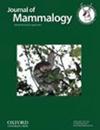黄耳蝙蝠属(Phyllostomidae, Stenodermatinae)中的一个墨西哥特有新种
IF 1.6
3区 生物学
Q2 ZOOLOGY
引用次数: 0
摘要
Vampyressa Thomas,1900 年属的蝙蝠在墨西哥的已知个体数量相对较少。通过最近在墨西哥西南部的采集工作,我们发现了几个以前未知的 Vampyressa 种群,它们似乎代表了一个独立于 V. thyone 但与 V. thyone 关系密切的品系。在此,我们将这一系描述为来自墨西哥格雷罗州和瓦哈卡州的 Vampyressa 属新种。目前,我们至少从 8 个地点采集到的 8 个标本和 3 个释放个体中了解到这一新种,并可根据其骨盆和头骨特征、体型、线粒体细胞色素 b 和核重组激活基因 2 序列数据将其与 V. pusilla 和 V. thyone 区分开来。新物种主要在低地捕获,但分布在海拔 150 米至 2 200 米的广阔海拔范围内。新物种的大部分记录来自特万特佩克地峡以西,这证明在这一生物地理屏障上出现了新的系统发育断裂。现在,Vampyressa 属包括 6 个物种,墨西哥作为新热带地区拥有最多特有蝙蝠的国家的地位得到进一步巩固,共有 20 种特有蝙蝠。本文章由计算机程序翻译,如有差异,请以英文原文为准。
A new Mexican endemic species of yellow-eared bat in the genus Vampyressa (Phyllostomidae, Stenodermatinae)
Bats from the genus Vampyressa Thomas, 1900 are known from a relatively small number of individuals in Mexico. Through recent collecting efforts in southwestern Mexico, we detected several previously unknown populations of Vampyressa, which appeared to represent a lineage independent from but closely related to V. thyone. Here, we describe this lineage as a new species of the genus Vampyressa from the Mexican states of Guerrero and Oaxaca. The new species is currently known from at least 8 collected specimens and 3 released individuals from 8 localities, and can be differentiated from V. pusilla and V. thyone based on pelage and skull characters, size, mitochondrial Cytochrome b, and nuclear Recombination-activating gene 2 sequence data. The new species has been captured mainly in the lowlands but occurs along a wide altitudinal range from 150 to 2,200 m above sea level. Most of the records of the new species are from west of the Isthmus of Tehuantepec, which evidences a new case of a phylogenetic break at this biogeographic barrier. The genus Vampyressa now includes 6 species, and Mexico expands its position as the country with the largest number of endemic bats in the Neotropics, totaling 20 endemics.
求助全文
通过发布文献求助,成功后即可免费获取论文全文。
去求助
来源期刊

Journal of Mammalogy
生物-动物学
CiteScore
3.30
自引率
5.90%
发文量
106
审稿时长
4-8 weeks
期刊介绍:
Papers are published on mammalian behavior, conservation, ecology, genetics, morphology, physiology, and taxonomy.
 求助内容:
求助内容: 应助结果提醒方式:
应助结果提醒方式:


